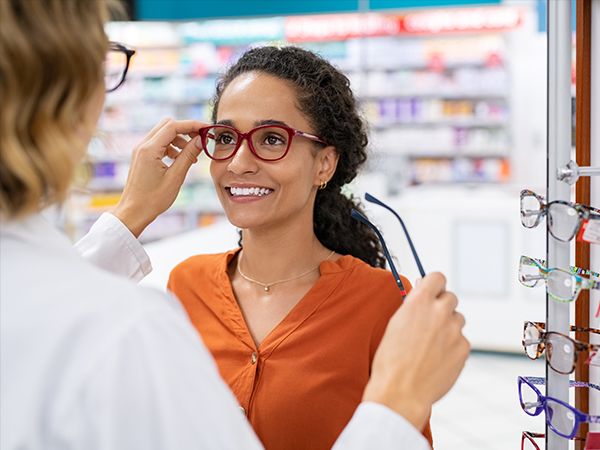As part of your annual eye exam, your doctor may perform some or all of these comprehensive tests, depending upon your individual needs:
CLARIFYE℠
CLARIFYE℠ is LensCrafters’ innovative digital eye-care technology that offers the most comprehensive eye health and vision assessment available. With CLARIFYE℠ we are able to map the unique “fingerprint” of your eyes with digital precision, to pinpoint the prescription you need to see your best.
Visual Fields Test
Checks for the presence of blind spots in your peripheral, or “side”, vision. These types of blind spots can originate from eye diseases such as glaucoma. Analysis of blind spots also may help identify specific areas of brain damage caused by a stroke or tumor.
Corneal Tonometry
An instrument that measures the pressure inside of the eye to determine one of the risks for developing glaucoma. If the pressure is high, an additional test may be used.
Stereopsis Test
Assesses depth perception and determines if eyes are working together. It is especially useful for identifying “lazy eyes” in children, which can be treated if identified while they are young.
Color Vision Test
Evaluates color deficiencies in the eyes (red/green or blue/yellow) by asking you to pick out numbers from colored mosaic-like illustrations. In addition to detecting hereditary color vision deficiencies, the results may also alert your doctor to possible eye-health problems that could affect your color vision.
Visual Acuity Test
A standard eye chart that measures the sharpness of your vision. Evaluates how well your current glasses or contact lenses are working, and if you need an updated prescription.
Cover / Eye Alignment Test
Uses a paddle to cover one eye at a time to help evaluate eye muscles. Can catch tendency toward crossed eyes in children. Helps evaluate for any indications of eye strain, which could be the result of strabismus or amblyopia.
Corneal Topography
Creates a map of the surface curvature of the cornea, similar to making a contour map of land. Using computerized imaging technology, the three-dimensional map produced by the corneal topographer aids in the diagnosis, monitoring and treatment of various visual conditions including astigmatism.
Contact Lens Evaluation
Evaluates multiple elements including the shape of your eye, your vision correction needs and how often you will use the lenses. If you’ve never worn contact lenses, your eye-care professional will show you how to use your lenses and how to take care of them.
Corneal Pachymetry
Measures the thickness of the cornea. Conventional pachymeters use ultrasonic transducers that touch the cornea. Newer generations work by way of sound waves that capture an ultra-high definition echogram of the cornea. Corneal pachymetry is an important test in the early detection of glaucoma.
Anterior Segment Imaging and Slit Lamp Exam
Allows your doctor a highly magnified view of your eye to thoroughly evaluate the front structures of your eye (lids, cornea, iris, etc.), followed by an examination of the inside of your eye (retina, optic nerve, macula and more). This test aids the doctor in the diagnosis of cataracts, dry eyes, corneal irritation, glaucoma and age-related macular degeneration.
Ocular Coherence Tomography (OCT)
Takes cross-sectional pictures of the retina via a scanning laser. This technology is used to diagnose and follow treatment in certain eye conditions and diseases, such as macular degeneration, glaucoma and diabetic retinopathy.
Wavefront Aberrometer / Corneal Analyzer
A digital vision-assessment system that combines topography, wavefront, autorefraction, keratometry, and pupillography in one instrument. This instrument helps improve accuracy when determining your glasses or contact lens prescription.
Optos California Ultra Wide Field Retinal Imaging
Creates a digital image that captures more than 80% of your retina in one panoramic image. Helps detect early signs of retinal disease including age-related macular degeneration, glaucoma and diabetic retinopathy.








